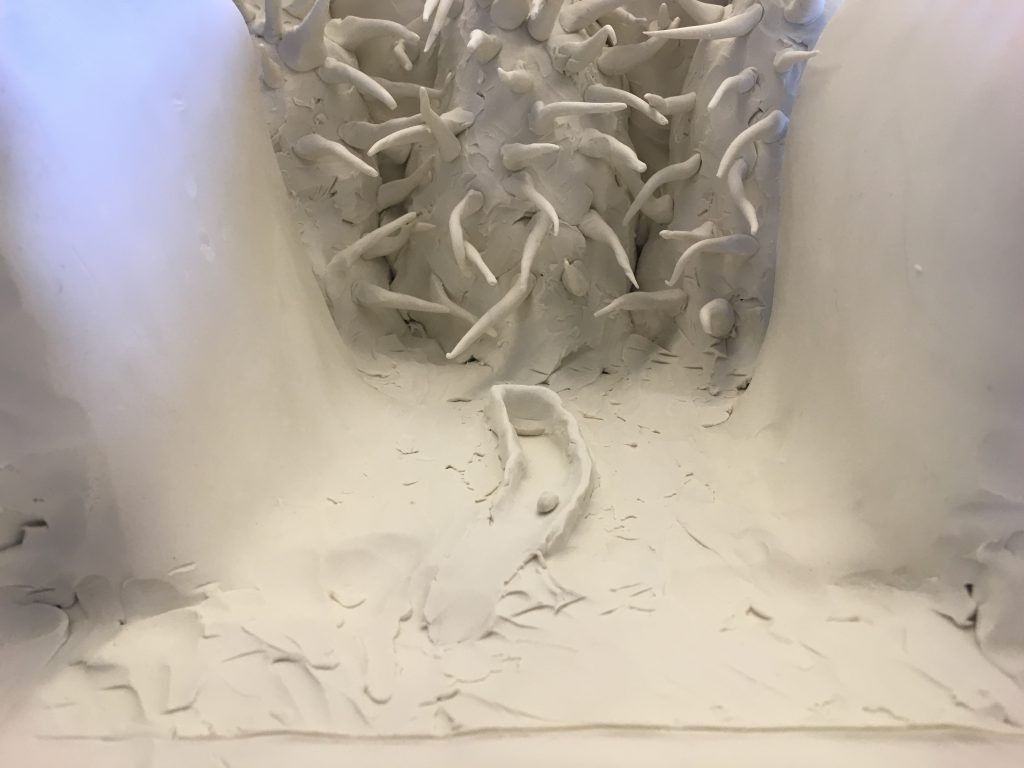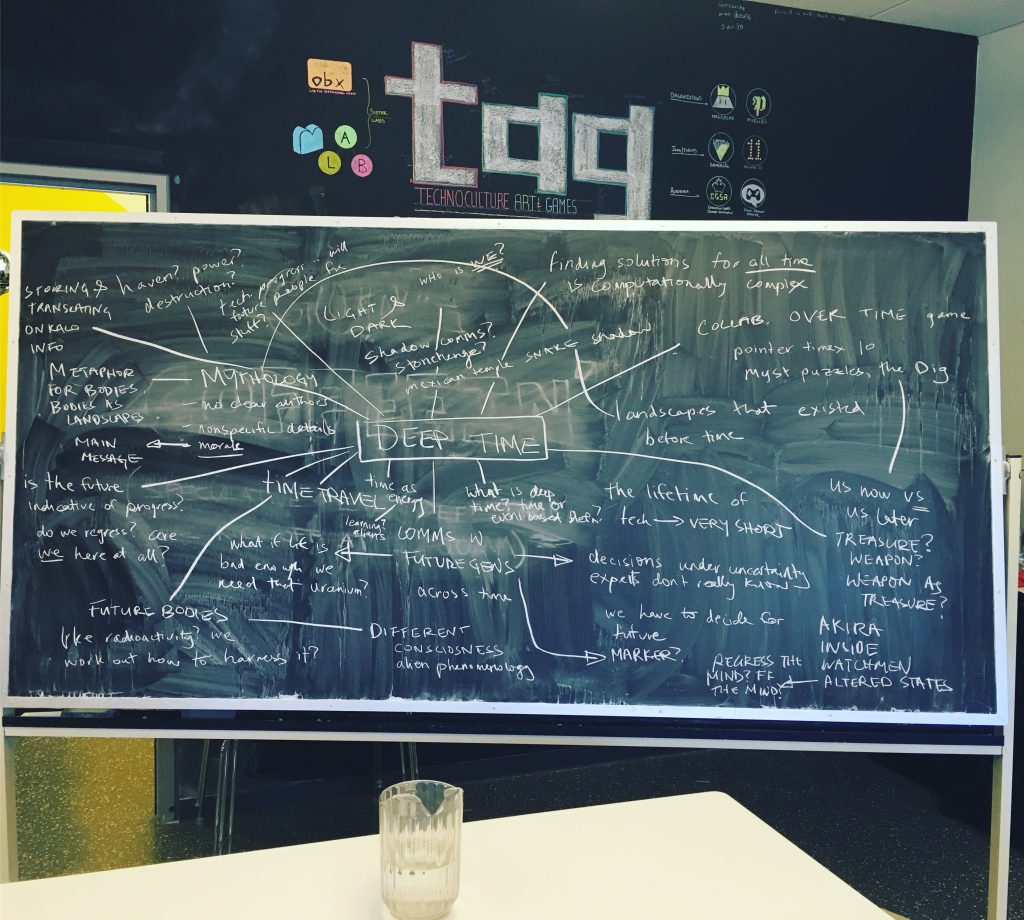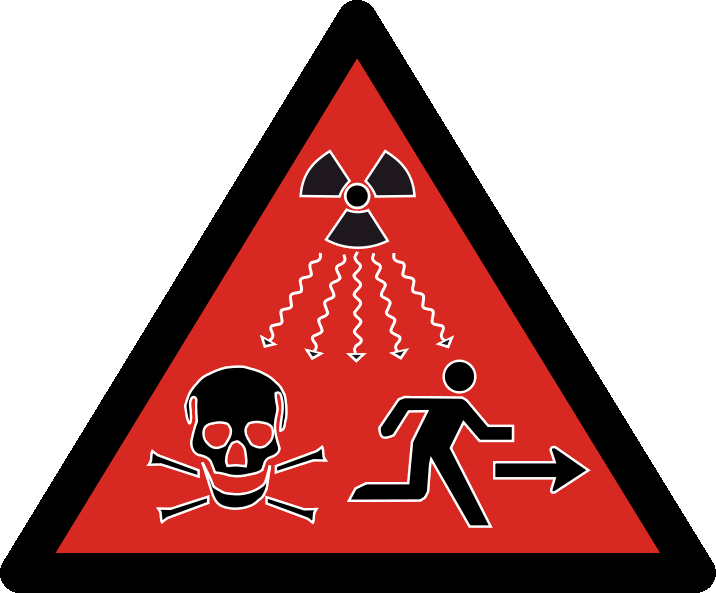After spending the weekend immersed in thoughts about Deep Time at the Speculative Play Deep Time jam this weekend, it turned out that my Monday night RPG/board game group didn’t have anything to play that night. During the weekend, we had watched “Into Eternity” (http://www.intoeternitythemovie.com/) and thought about Onkalo (a waste-storage facility being built 4 or 5 kilometers deep in the Finnish bedrock), as well as nuclear waste more generally. Our discussions about deep time had talked about problem of designing for someone who might or might not share the same physical attributes, sensibilities, and senses. We talked about how difficult it was for the human brain to conceptualize a 100 000-year time-span, given that our own recorded history is so short and yet older events still feel so remote. We talked about intergenerational communication and responsibility, the durability of different materials and how to communicate broad strokes in imprecise mediums – perhaps things like massively-scaled stones, or “universal” symbols like thorns or other things that might represent danger to some unknown beings. We also thought about whether such warnings would only spur on treasure-seekers, who, unconvinced of the altruism of the people sending such a message (well, altruism except in the sense of assuaging our own guilt, perhaps), might think that something valuable was being hidden from them. And, given that nuclear waste materials can be reprocessed, and that a relatively small amount of their energy is used before the material is considered waste, it might be considered valuable indeed.
Given that I am moving to Alberta fairly soon and that our membership is already becoming increasingly scattered (Guelph, NYC, Regina…), the RPG group is working on strategies for being able to continue playing when we’re apart. So far, we have had mixed results with digital play, and of course it comes with a whole host of potential challenges with regards to tech, lag, internet issues, etc. Meeting for a casual board game wouldn’t further that cause at all, and I had been itching to run a game of my own for some time. I used to run a Star Wars expanded universe campaign, but it became too much for me to manage, and so I hadn’t actually “GMed” in years — there just seemed to never be enough time. Fresh off of discussions from the weekend, I decided that, given a simple enough system (Fate Accelerated, in our case), I could indeed run a one-shot campaign on-the-fly that evening.
I decided that I would give the group very little context, asking them only to give me information about who they were as a people (human, genetically-modified/differently-evolved humans, aliens). Their constraint was that they had to be of a similar size to humans (somewhere between human-sized and elephant-sized). My primary goal was to balance feasibility and fun, and so I did have to invent and alter certain details that may not be within the realm of possibility. Admittedly, although the results of this campaign were an interesting enough way into this design problem that I am now writing about it for you here, my primary motivation was running the game in a way that would be compelling for the players. Having dedicated so much thought and consideration to Deep Time and Onkalo over the weekend made them convenient subjects for exploration, and I thought that the ideas would work well in a one-shot campaign rather than something more sustained.
The players were experienced roleplayers from different backgrounds, although all were Canadians from the East Coast (Ontario and Quebec), including a biochemist, a store manager, a researcher working with Montreal’s itinerant population, and a bank worker. Although the group usually has an even gender split, the players this time were three male-identified players and one female-identified player.
Here is what they decided about themselves, their society and their context:
The game was to taking place 90 000 years in the future. The group was part of a race of genetically-modified humans that eventually evolved further to become quite sea-mammal like — specifically, they decided that they were the Otterfolken and had large lung capacity, webbed hands and feet, oily fur to protect themselves from cold in the water. They also decided that they would have bronze-age technology (and were quite insistent that this should include Archimedes’ death ray). Their characters were part of a caravan traveling across the land, seeking trade goods. One of them was the caravan chef and mixer-of-medicines, one of them was a religious elder/prophet who had visions, one was the caravan funder, a rich otterperson who was seeking adventure, and the other was a youngling who was in charge of caring for the caravan’s animals (these pack animals were known as “Finless”). Additionally, I seeded the adventure by giving them each one piece of information that none of the other players knew: the rich caravan funder knew that there were areas on this landmass that had not yet been scavenged by other caravans, the animal-tender knew that the area they were entering had very hard bedrock and was considered very stable (not prone to natural disasters, volcanoes, flooding, etc.), the caravan cook knew that food sources were getting more scarce and the land less hospitable as they ventured onwards, and the religious leader knew that there were legends/stories told in his religion about “places that you are supposed to forget, places that no one should ever go, deep places, sacred places” and that most of these were on land.

(That tiny track and even tinier truck represent the entrance to Onkalo).
Over the course of the weekend, Rilla Khaled and I explored questions around what we ended up calling “communicative geographies” — what kinds of human-made geographies could be used to primally communicate, beyond language, that Onkalo was a place to be feared. Using plasticine (reusable modeling clay), tin foil, and plastic cups, we built a structure that was designed to surround Onkalo. We were inspired by the shape of the Hoover dam — smooth, and descending at a terrifying angle — and by the idea, brought up in “Into Eternity,” that thorns were a threatening shape, one that might potentially still be understood in 100 000 years. So, Rilla and I surrounded the entrance to Onkalo with spikes on two sides and Hoover Dam-like curves of self-healing concrete (using bacteria) (knowing that such concrete is probably not infinitely self-repairing, we still decided to imagine it as such in a speculative future), all of this on a massive scale designed to inspire feelings of the sublime in the viewer.
For the RPG, I thought about Onkalo as more of a fortress – the huge thorny spikes on the outside, and smooth, Hoover-dam inspired bowl on the inside. To make it possible for the game to proceed, I decided that at some point since their creation, one small section of the spikes had fallen or been sheared off, allowing a climbable surface in one spot, should the adventurers decide to undertake such a climb.
Additionally, I surrounded Onkalo with other safe guards, attempts at communication: obelisk-like structures (some which had collapsed) with information in every known language, and a field of flowers, genetically-engineered to recoil away from other varieties to help them grow in set patterns (and also poisonous), forming the shape of a giant pictorial radiation warning as seen in the Onkalo film. However, the warning was designed to be seen from a birds-eye view, and they could not completely discern the pattern, although that they knew there was one (until, of course, they reached the top of the ominous structure, looked back and said “Oh, no!” — but their characters didn’t understand the symbols anyhow).
As the game played out, it became clear that the players, with no context, were playing out scenarios and thinking in ways that were consistent with our discussions over the weekend. When faced with a mystery, and in the context of the RPG, their solution was to go further and solve it. When presented with ominous symbols and danger, they decided that there must be something worth protecting hidden beyond — and, in the case of one character, their primary motivation was adventure-seeking, and this definitely looked like adventure.
The fact that this all took place in the context of an RPG night can’t be overlooked. This is the metagame — the tension between player knowledge (such as knowing the symbol for radioactivity) and character knowledge. The players knew, of course, that if I was leading them towards a certain place, there would be danger. This place wouldn’t just contain a pile of treasure for them to find. And although they discussed turning back many a time, they never did. The context of the game (and perhaps the lack of real-world stakes) encouraged them to move forward rather than turn back. But is the curiosity that drove the Otterfolken to Onkalo only human?
As I slowly pulled back the curtain and they discovered maps of the space within the Onkalo archives as well as more obelisks with writing and symbols, the group seemed driven by two motivations: uncover the rest of the mystery, and act according to the characters that they had set out for themselves. Afterwards, I gave them context for their adventure, telling them about “Into Eternity,” Onkalo and the weekend’s projects and adventures.
After this foray into using RPGs to explore a design problem, I’m convinced of their potential value as a design probe, especially for the Speculative Play project. Given time and space to do so, all humans are capable of speculation.


